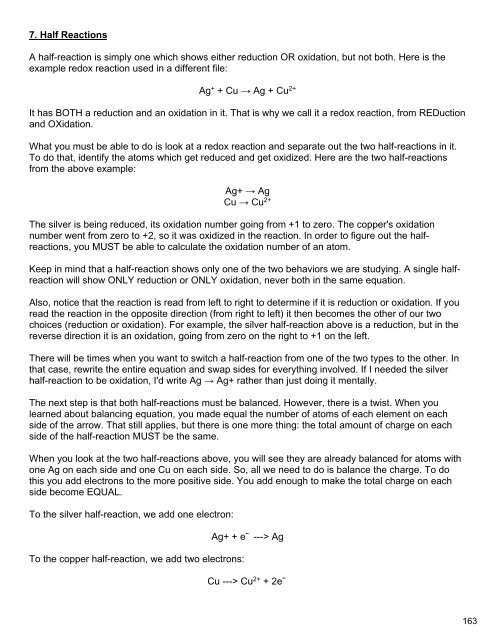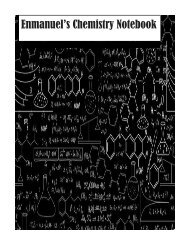Create successful ePaper yourself
Turn your PDF publications into a flip-book with our unique Google optimized e-Paper software.
7. Half Reactions<br />
A half-reaction is simply one which shows either reduction OR oxidation, but not both. Here is the<br />
example redox reaction used in a different file:<br />
Ag + + Cu → Ag + Cu 2+<br />
It has BOTH a reduction and an oxidation in it. That is why we call it a redox reaction, from REDuction<br />
and OXidation.<br />
What you must be able to do is look at a redox reaction and separate out the two half-reactions in it.<br />
To do that, identify the atoms which get reduced and get oxidized. Here are the two half-reactions<br />
from the above example:<br />
Ag+ → Ag<br />
Cu → Cu 2+<br />
The silver is being reduced, its oxidation number going from +1 to zero. The copper's oxidation<br />
number went from zero to +2, so it was oxidized in the reaction. In order to figure out the halfreactions,<br />
you MUST be able to calculate the oxidation number of an atom.<br />
Keep in mind that a half-reaction shows only one of the two behaviors we are studying. A single halfreaction<br />
will show ONLY reduction or ONLY oxidation, never both in the same equation.<br />
Also, notice that the reaction is read from left to right to determine if it is reduction or oxidation. If you<br />
read the reaction in the opposite direction (from right to left) it then becomes the other of our two<br />
choices (reduction or oxidation). For example, the silver half-reaction above is a reduction, but in the<br />
reverse direction it is an oxidation, going from zero on the right to +1 on the left.<br />
There will be times when you want to switch a half-reaction from one of the two types to the other. In<br />
that case, rewrite the entire equation and swap sides for everything involved. If I needed the silver<br />
half-reaction to be oxidation, I'd write Ag → Ag+ rather than just doing it mentally.<br />
The next step is that both half-reactions must be balanced. However, there is a twist. When you<br />
learned about balancing equation, you made equal the number of atoms of each element on each<br />
side of the arrow. That still applies, but there is one more thing: the total amount of charge on each<br />
side of the half-reaction MUST be the same.<br />
When you look at the two half-reactions above, you will see they are already balanced for atoms with<br />
one Ag on each side and one Cu on each side. So, all we need to do is balance the charge. To do<br />
this you add electrons to the more positive side. You add enough to make the total charge on each<br />
side become EQUAL.<br />
To the silver half-reaction, we add one electron:<br />
To the copper half-reaction, we add two electrons:<br />
Ag+ + e¯ ---> Ag<br />
Cu ---> Cu 2+ + 2e¯




